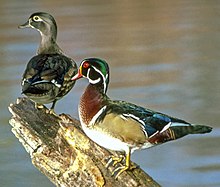Wood duck
Template:Taxobox begin
Template:StatusLeastConcern
Template:Taxobox image
Template:Taxobox begin placement
Template:Taxobox regnum entry
Template:Taxobox phylum entry
Template:Taxobox classis entry
Template:Taxobox ordo entry
Template:Taxobox familia entry
Template:Taxobox genus entry
Template:Taxobox species entry
Template:Taxobox end placement
Template:Taxobox section binomial
Template:Taxobox end
The Wood Duck (Aix sponsa) is a medium-sized perching duck. An adult is about three-quarters of the length of an adult Mallard.
The adult male has distinctive multi-coloured iridescent plumage and red eyes. The female, less colourful, has a white eye-ring and a whitish throat. Both adults have crested heads. When swimming, wood ducks bob their head back and forth in a jerking motion, which makes them easy to spot.
Their breeding habitat is wooded swamps, shallow lakes, marshes or ponds in eastern North America and the west coast of the United States. They usually nest in cavities in trees close to water, although they will take advantage of nesting boxes in wetland locations if available. Their personality is however somewhat shy and skittish.
Females typically lay between 9 and 14 eggs. However, if nesting boxes are placed too close together, females may lay eggs in the nests of their neighbours, which may lead to nests which may contain as many as 40 eggs and unsuccessful incubation. The day after they hatch, the young climb to the nest entrance and jump to the ground.

They overwinter in the southern United States near the Atlantic coast. In the southern parts of their range, they may be permanent residents.
These birds feed by dabbling or walking on land. They mainly eat plants and seeds.
The male's call is a rising whistle; the female gives a whistled whoo-eek if startled.
The population of the Wood Duck was in serious decline at the beginning of the 20th century as a result of over-hunting and loss of suitable nesting sites. Changes in game laws and the construction of nesting boxes in suitable habitat resulted in this species' return to sustainable numbers.
